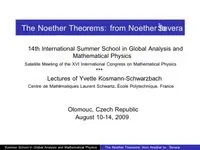Table Of Contentˇ
The Noether Theorems: from Noether to Severa
14th International Summer School in Global Analysis and
Mathematical Physics
Satellite Meeting of the XVI International Congress on Mathematical Physics
***
Lectures of Yvette Kosmann-Schwarzbach
Centre de Math´ematiques Laurent Schwartz, E´cole Polytechnique, France
Olomouc, Czech Republic
August 10-14, 2009
Summer School in Global Analysis and Mathematical Physics The Noether Theorems: from Noether to Sˇevera
Lectures 4 and 5
Lie Algebroids and Courant Algebroids in the
Lagrangian and Hamiltonian Formalisms
Summer School in Global Analysis and Mathematical Physics The Noether Theorems: from Noether to Sˇevera
References
◮ Alan Weinstein,
Lagrangian mechanics and groupoids,
Fields Inst. Commun. 7 (Waterloo, ON, 1992),
Amer. Math. Soc., Providence, RI, 1996, 207–231.
◮ Paulette Libermann,
Lie algebroids and mechanics,
Arch. Math. (Brno) 32 (1996), no. 3, 147–162.
◮ Eduardo Mart´ınez,
Lagrangian mechanics on Lie algebroids,
Acta Appl. Math. 67 (2001), no. 3, 295–320.
◮ Pavol Sˇevera,
Some title containing the words “homotopy” and
“symplectic”, e.g. this one,
Travaux math´ematiques (Luxembourg) 16 (2005), 121–137.
Summer School in Global Analysis and Mathematical Physics The Noether Theorems: from Noether to Sˇevera
References (continued)
◮ David Saunders, Michael Crampin,
Variational problems on Lie algebroids,
Differential Geom. Appl. 15 (2001), no. 2, 165–174.
◮ V. A. Golovko, Joseph Krasil’shchik, A. M. Verbovetskii,
Variational Poisson-Nijenhuis structures for partial differential
equations,
Teoret. Mat. Fiz. 154 (2008), no. 2, 268–282; translation in
Theoret. and Math. Phys. 154 (2008), no. 2, 227–239.
Summer School in Global Analysis and Mathematical Physics The Noether Theorems: from Noether to Sˇevera
Motivation
Weinstein was motivated by the study of discrete Lagrangian and
Hamiltonian systems. The natural framework for discrete systems
is that of Lie groupoids.
For the case of continuous time, the natural framework is that of
Lie algebroids.
For 1-dimensional variational problems – the case of mechanics –
the framework of Lie algebroids extends that of tangent bundles.
For 2-dimensional problems, introduce Courant algebroids
(Sˇevera).
Summer School in Global Analysis and Mathematical Physics The Noether Theorems: from Noether to Sˇevera
Back to basics
Let M be a manifold, TM → M its tangent bundle.
∞
Let Γ(TM) be the C (M)-module of sections of TM (the space
of vector fields on M).
Fact. The Lie bracket of vector fields makes Γ(TM) a
LIE ALGEBRA over R:
skewsymmetry [X , Y ] = −[Y , X ] and
Jacobi identity [X , [Y , Z ]] = [[X , Y ], Z ] + [Y , [X , Z ]]
Fact. The Lie bracket of vector fields satisfies the
LEIBNIZ IDENTITY:
∞
∀X,Y ∈ Γ(TM), ∀f ∈ C (M), [X , fY ] = f [X , Y ] + (X · f )Y
Lie algebroids are “generalized tangent bundles”
Summer School in Global Analysis and Mathematical Physics The Noether Theorems: from Noether to Sˇevera
Definition of Lie algebroids
Definition
A Lie algebroid is a vector bundle τ : A → M such that
• Γ(A) is a LIE ALGEBRA over R
(skewsymmetry + Jacobi identity)
• there exists a morphism of vector bundles ρ : A → TM, called
the anchor, such that the LEIBNIZ IDENTITY is satisfied,
∞
∀X,Y ∈ Γ(A), ∀f ∈ C (M), [X , fY ] = f [X , Y ] + (ρ(X) · f )Y
Proposition (yks and Franco Magri)
The mapping ρ induces a Lie algebra homomorphism
Γ(A) → Γ(TM).
Summer School in Global Analysis and Mathematical Physics The Noether Theorems: from Noether to Sˇevera
Examples
◮ TM
◮ foliations: integrable subbundles of TM
◮ cotangent bundle of a Poisson manifold, (M, π)
∗
there exists a unique Lie algebroid structure [ , ]π on T M
such that
♯ ∗
the anchor is the map π : T M → TM defined by π, and
∞
[df , dg]π = d{f , g}, ∀f , g ∈ C (M).
◮ gauge Lie algebroids (also called Atiyah algebroids): TP/G,
where P is a principal bundle with structure group G.
◮ action Lie algebroids : g × M, where g is a Lie algebra acting
on M.
Summer School in Global Analysis and Mathematical Physics The Noether Theorems: from Noether to Sˇevera
The differential of a Lie algebroid
• ∗
For any Lie algebroid A, there is a differential dA on Γ(∧ A )
defined by
∑
k i ̂
(dAα)(X0, X1, . . . , Xk) =
i=0(−1) ρ(Xi ) · α(X0, . . . , Xi , . . . , Xk)
∑
i+j ̂ ̂
+
0≤i<j≤k(−1) α([Xi , Xj ], X0, . . . , Xi , . . . , Xj , . . . , Xk),
k ∗
for α ∈ Γ(∧ A ), k ∈ N, X0, . . . , Xk ∈ ΓA.
2
dA = 0
• ∗
The differential dA turns Γ(∧ A ) into a complex
whose cohomology is called the Lie algebroid cohomology
•
and is denoted by H (A).
Summer School in Global Analysis and Mathematical Physics The Noether Theorems: from Noether to Sˇevera
The de Rham differential and
the Chevalley–Eilenberg differential
When A = TM, the differential dA acts on the differential forms
• ∗ •
Γ(∧ (T M)) on the manifold M, and H (A) is the de Rham
cohomology of M.
When A is a Lie algebra considered as a Lie algebroid over a point,
•
H (A) is the Chevalley–Eilenberg cohomology.
• ∗
The Lie derivative of sections of Λ A with respect to X ∈ ΓA is
defined by LX = [iX , dA],
• ∗
where [ , ] is the graded commutator of derivations of Γ(∧ A ).
Summer School in Global Analysis and Mathematical Physics The Noether Theorems: from Noether to Sˇevera

